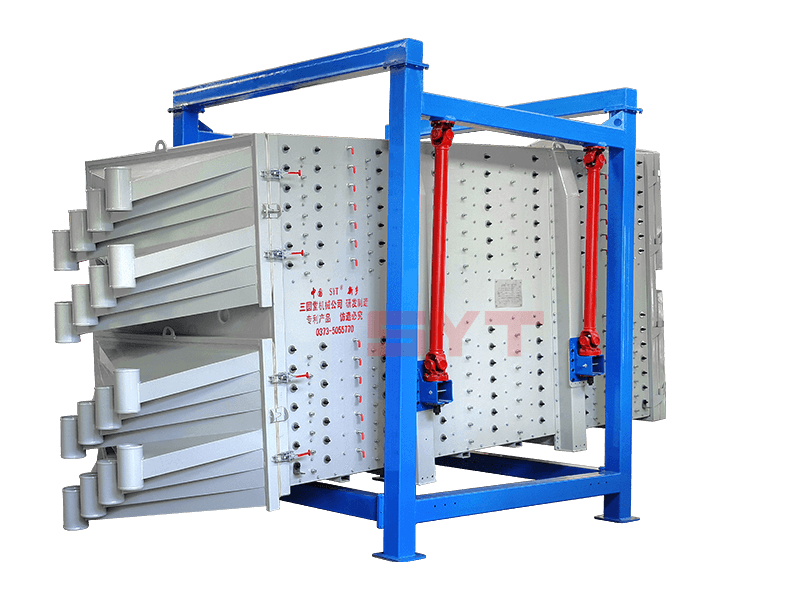
The industrial sand screening machine, also called the vibrating sand screening machine, is a key equipment in the sand and gravel production line. Its main function is to classify the crushed sand according to different particle sizes coarse, medium, and fine (first remove the coarse particles larger than 5mm). When designing a sand and gravel production line, due to the high production requirements of the industry, multiple devices are usually required to run in parallel. Even a small production line requires at least two or more vibrating screen devices. The sand screening machine is suitable for screening finished sand and gravel, but also for classifying materials after primary and secondary crushing, and realizes efficient screening through multi-layer screens to improve production efficiency.
Multi-layer Classification
1-5 layers of multi-layer design (complex can reach 10 layers), screening particle size 0.3mm-180 mesh, effectively screen various types of dry sand, and divide the sand into different grades according to different particle size requirements.
Large Output
Large processing capacity, the output of a single unit is 3-6 times that of an ordinary sand screening machine, and the output can reach 25 tons/hour.
High Screening Efficiency
Adopting multi-layer classification (generally 3 to 9 layers), large inclination angle (generally 30° to 60°), large sieve hole (sieve hole size is 2 to 10 times the separation particle size), the screening efficiency is as high as more than 96%.
Self-cleaning Screen Device
Each layer of the screen has a screen anti-blocking cleaning device to effectively prevent the screen from blocking.
Beautiful Shape
Large-scale electrostatic spraying process, the equipment is more beautiful, wear-resistant and rust-proof.
Fully Enclosed Structure
Dust does not fly, the screen machine has small vibration and low noise, which meets environmental protection requirements.
Solid Structure
The design structure is simple and solid, wear-resistant and corrosion-resistant, and can operate stably for a long time in harsh working environments.
After the dry sand enters the screening system through the feed port, the screen vibrates up and down, causing the material to roll on the screen surface. Larger particles slide along the screen surface and are discharged, while smaller particles are screened through the screen holes. By using screens of different specifications, the particle size classification and precise separation of materials can be effectively achieved.
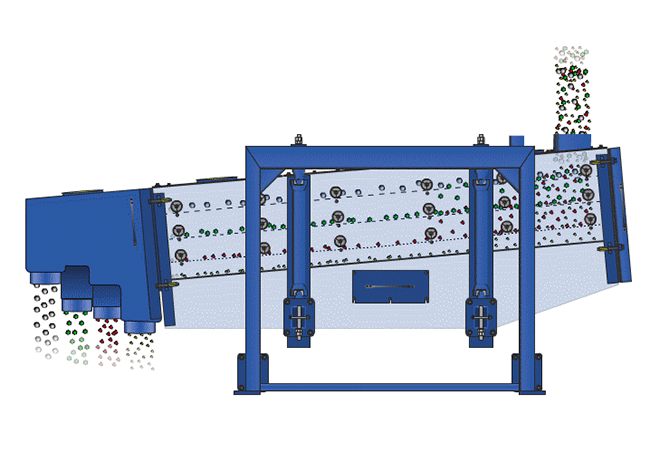
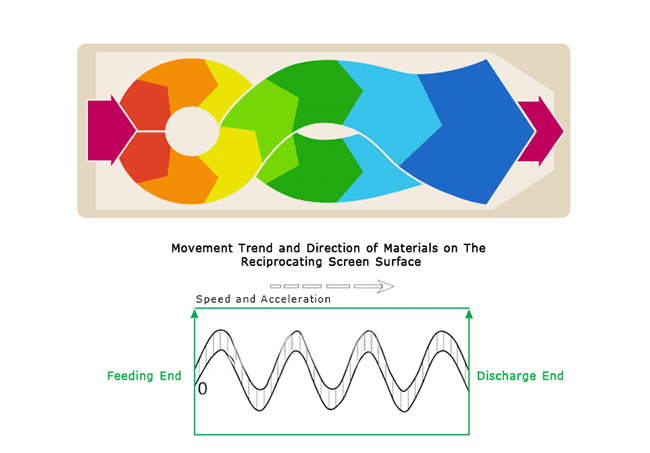
The sand screening machine is mainly composed of components such as the feed port, screen box, drive device, screen frame, support frame, vibration reduction device, and discharge port. The design can be customized according to needs, such as single vibration source or double vibration source, screen hole size, screen material, additional dust collection holes, observation holes, inclination angles, length, width, and height, and customized special-shaped feeding ports and discharge ports.
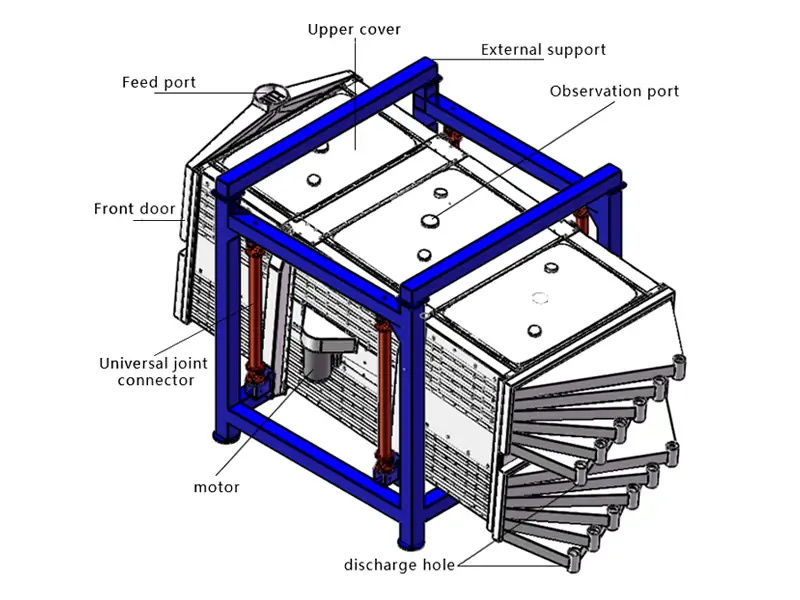
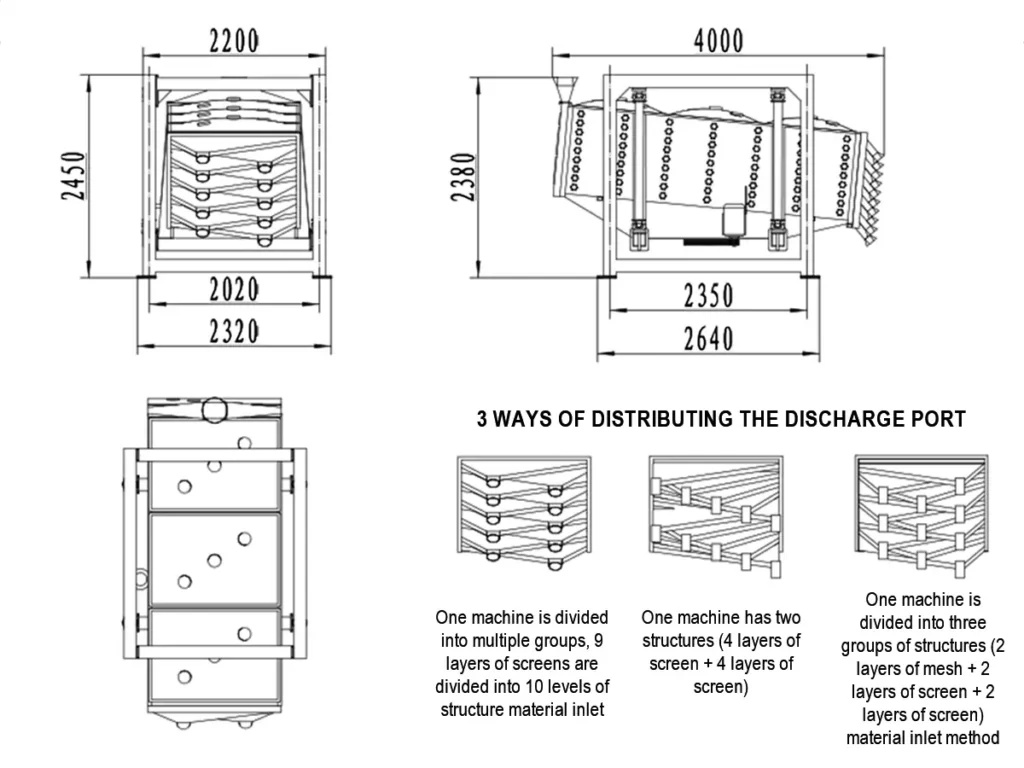
| Model | Screen size | Screening area | Screen inclination | Layers | Power | Number of turns | Case travel |
| FYBS1536 | 1.5*3.5 m | 4.5-9 ㎡ | 0-5° | 1-10 | 5.5 kw | 180-260 | 25-60 mm |
| FYBS2040 | 2.0*4.0 m | 8-9 ㎡ | 0-5° | 1-10 | 7.5 kw | 180-260 | 25-60 mm |
Stone quarry: used for stone classification and separation of soil and stone powder.
Sandstone quarry: used for efficient separation of sand and stone.
Coal industry: used for separation of lump coal and coal powder, and as a component of coal washing equipment.
Mineral processing industry: used for ore classification and separation of powdered materials.
Used for screening and grading quartz sand, common particle size specifications include: 0.5-1mm, 1-2mm, 2-4mm, 4-8mm, 8-16mm, 16-32mm, and 10-20 mesh, 20-40 mesh, 40-80 mesh, 100-250 mesh, etc. These specifications can meet the needs of different applications and ensure that the particle size of quartz sand meets the use requirements.
As an abrasive, corundum needs to be screened. Common specifications include: 0-1mm, 1-3mm, 3-5mm, 5-8mm, 8-10mm, 36 mesh, 46 mesh, 60 mesh, 80 mesh, 100 mesh, 200 mesh, 325 mesh, etc. At the same time, the particle size specifications of fine powder can be adjusted according to customer requirements to flexibly meet needs.
This sand-making and screening machine can be equipped with 1 to 8 removable screen layers according to the production needs of users. It can screen out 7 to 9 kinds of machine-made sand of different particle sizes, with a maximum output of 40 tons per hour.
The sand screening production line is Sanyuantang's most mature and stable complete set of fracturing sand screening system. The system consists of crusher, belt conveyor, bucket elevator, silo, square gyratory screen, dust removal equipment, etc. In the sand and gravel production line, multi-layer vibrating sand screening machines are usually used in parallel to complete the screening of materials of various particle sizes at one time, greatly shortening the production time, while ensuring that the particle size and shape of the finished aggregate meet the requirements. The design can be customized according to customer requirements, and the equipment can be configured for the production site.

Large output: The output can reach 10-30 tons/hour, meeting the needs of large-scale production.
High production efficiency: The system equipment is closely matched, the production efficiency is high, and the rapid screening and processing of sand and gravel materials can be realized.
Stable operation: The structure is strong, the operation is stable, the failure rate is low, and it can run stably for a long time, reducing downtime.
Easy maintenance: The sand production line system equipment is easy to maintain and maintain, reducing the cost of use.
High degree of automation: The entire production line adopts an automated control system, equipped with automatic start and stop, fault alarm and remote monitoring functions.
In a sand and gravel production line, a sand screen is a common device for users. Its efficient screening ability plays a key role in the quality and output of sand and gravel. To ensure the screening effect, there are several points that need special attention during use:
When the screening order is from coarse to fine, the screens should be stacked according to the particle size, with the coarse screen on top. This arrangement can reduce the wear of the screen. When the excitation force of the sand screen is increased, fine particles can pass through all screens more easily, thereby reducing the probability of fine particles being mixed with coarse materials.
If you choose to screen from fine to coarse, in order to facilitate material discharge and reduce the inclusion of fine particles, a sand screen with a larger structure should be selected. All materials pass through a fine screen first, which can improve the screening efficiency, but the wear rate of the fine screen will be accelerated.
During the screening process, wet screening or dry screening should be selected according to the mud content and water content of the material. During the wet screening process, it is necessary to sprinkle water appropriately to reduce the viscosity of the soil and prevent the screen from being blocked. Dry screening is suitable for situations with less mud and water content.
Thirty years of dedication have allowed us to accumulate extensive production and service experience, enabling us to solve various challenges in powder processing for our numerous clients.
Innovation is the lifeblood of our company's development. To date, we have obtained over 40 domestic and international patents, with many of our products holding multiple patents.
We specialize in undertaking the design and production of fine powder processing production lines, offering a one-stop service from crushing, screening, conveying, feeding, mixing to packaging.
Upon receipt of the products, detailed English user manuals are provided. For relatively complex installations or product usage, video installation guidance is available. For large-scale technical projects, we can dispatch professional technical personnel for on-site installation guidance.
 Please fill in the informationWe provide you with personalized solutions
Please fill in the informationWe provide you with personalized solutionsIf you do not know how to select, please call us or leave a message online. We will serve you wholeheartedly!